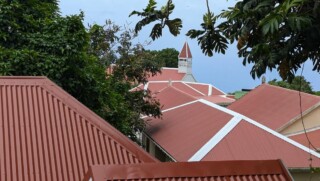Information evening for Immigrants sees massive turnout

Researcher Gerjanne Voortman (right) gives an overview of the conclusions of research she has conducted on the position of Immigrants on the island. Photo: Government of Bonaire.
Kralendijk – Researcher Gerjanne Voortman recently presented the main results of the investigation into the situation of immigrants in Bonaire that she conducted on behalf of Project Integrated Neighborhood Approach (part of the Public Entity of Bonaire). The hall in Oceanway Tera Cora was filled with 160 immigrants, mostly of Latin American background. The language during the presentation was Spanish. “While the number of immigrants increases in Bonaire, we know very little about the situation of immigrants who sometimes live are traveling for years on the island”, says Voortman.
The cultural anthropologist last year held interviews, conducted an extensive survey and walked with a district worker, to understand the problems and priorities of the immigrants themselves and of the entities with which they are dealing. The main issues that emerged are: ignorance about rights and obligations, language barriers and exploitation in the workplace.
These problems, according to Voortman, are clearly related to each other. “Because people are not aware of their own rights and duties, they are vulnerable in the workplace. Because they do not speak Dutch and Papiamento, useful information from for instance the Government, is not understood. It is very important that people know their rights as workers, but also their rights as citizens and what their own responsibilities”, according to the researcher.
In this study, the definition of immigrant was defined to Bonaire residents born outside the Kingdom of the Netherlands, regardless of their legal status and years of residence on the island. This group together forms a quarter of the people on Bonaire. The largest communities within this population are Dominicans, Colombians, Venezuelans and Peruvians. Among the immigrants on Bonaire many people work in catering, cleaning, construction, or as a shopkeeper. A particularly high proportion of them are entrepreneurs.
Notable is the absence of this quarter of the population in government and service functions. This is due largely to language barriers. Of immigrants living on the island 10 years or more, only 9% is able to speak Dutch. According to Voortman, especially for highly educated immigrants, the command of Dutch would be key to better job opportunities.
After the presentation, there was a lively discussion led by the leader of the Project Integrated Neighborhood Approach, Max Suart. While the audience obviously wanted to know how the problems will now be solved, there were few concrete answers. According to Voortman, the diagnosis has now been made by this study and made recommendations for improvements have been outlined. Solutions according to Voortman and Suart will require cooperation of- and cooperation among the various national and local government agencies.












